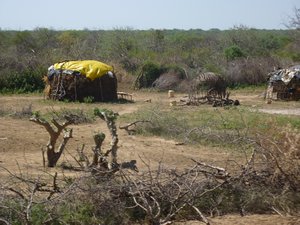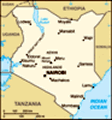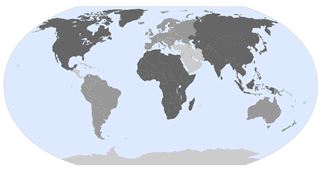Advertisement
Published: February 4th 2010

 Nomad Houses
Nomad Houses
They look rough until you get inside where they are reasonably comfortable, if squeezy. They carry the roof, burn the rest.It is now a little over half way through our trip from Cairo to Capetown. We have a 5 day layover in Nairobi and it looks like we have found a nice, relaxing place to chill out for a while. The trip so far has not been hectic. Constant is probably a better word. Up most mornings at or around dawn and into it. Some days it is just half a day travel and others are full, hard days. We have only had to camp in the dark once. Most of the camp are so tired that they are in bed a little after 9.00pm at night, although there are a few of us who are capable of going a little later.
From Nairobi the group will change dramatically. 8 people are leaving and I think there will be 13 coming on. Any new people change the dynamics of the group and, with the new people being in the majority, it will be interesting to see how the group settles in for the run down to Capetown. It appears that a there is a higher proportion of young people in the newbies and that will also be interesting.
The

 New Type
New Type
Look a little like they might be more coldtruck has had a few problems in the last couple of weeks, although nothing that gave us too much difficulty. A lot of blue smoke, particularly in the highlands, indicated that there was a difficulty with the engine. Turned out to be a need for new piston rings. These weren't available in the parts of Ethiopia that we were travelling through so we continued. The truck wasn't too sick. Then the clutch plate collapsed. We made for Moyale - on the border between Ethiopia and Kenya - where there was likely to be equipment that would be necessary to allow the lifting of the 300kg gear box. There had been a plan to go through Moyale but we ended up staying a couple of nights in a nice pub - the Kroket hotel I think. A day of bludging around buying the last Ethiopian bangles, reading and maybe having a drink or two for us. A day, and most of the night, removing the gear box and replacing the clutch for the two leaders/ drivers. It obviously wasn't all beer and skittles for them either. The blokes in the workshop learnt a lot of new words that they delivered in

 Tough Country
Tough Country
Northern Kenya. There has been fighting here over time. Not sure it is actually worth it but obviously is to some.chorus as we drove out of town at 6.00 am next morning.
Kenya is very different from Ethiopia. The early part from Moyale to Marsabit is pretty rough country with roads as bad as any we have travelled on. A little like the Tanami Track but with a lot of rock - for those who know it. Not a lot of fun in a large ex-concrete truck, but bearable. From Marsabit on the roads have improved, although road building is not an obvious priority here. The country and the living conditions, on the other hand, have improved a lot.
Marsabit is a largish town up into the highlands from the rougher land that we have been travelling through. It is a more fertile area and must receive quite a deal more rain than the country to the north. There is a stronger Moslem influence here than earlier. The hotel - the JeyJey - that we stayed in was dry. Service was good and the hotel was OK even though the great lack of water created some toilet and washing issues. The food is now different and we are into maize meal with everything. Filling stuff and not bad
provided that the gravy is tasty and there is plenty of it.
From Marsabit we travelled through highland, fertile country towards Samburu National Park where we were to have our first real 'animal' experience. The Samburu are people who told us that they are the cousins of the Masai who moved south as the grazing lands to the north were either no longer viable or they were forced out. There is a fair degree of inter-marriage between the two tribal groups. The culture of the two tribes is apparently similar. They both eat primarily maize meal - which they trade for - and a mixture of blood and milk along with some meat. Cattle and goats are killed for meat but there seems to be a strong desire to keep as many alive as possible. The condition of much of the land is testimony to the numbers of stock and the lack of rain.
The Samburu National Park doesn't seem to have the masses of wildlife that you might expect but there were plenty to impress me. On our first game drive we were able to get very close to giraffes, elephants, oryx, antelopes and impalas, a single

 Checking us Out
Checking us Out
Reticulated giraffe. A lot about and we were very closesolitary zebra and a lion. The birdlife was spectacular and there was plenty of it. The game drive next morning was more extensive. We spotted Cape buffalo - which have a different head and horns from the Asian water buffalo that we are very used to. We also had a very good elephant experience and, of course, drove past the many antelope of different types. Great stuff and provides some balance to the numbers of churches and other religious places I have had to put up with.
At Samburu we had our first flash dinner in a major resort. A big buffet with the price in USD. Some of us made pigs of ourselves on the 4 courses with a variety of soups, salads, roast meats, fish, veggies and desert. It was a good feed although you wouldn't be able to do it every day.
Next night we stayed in a Samburu village that has made the decision to try to use tourism to replace much of the income they previously obtained from cattle and goats. The difference from our Omo experience could not have been more pronounced. We were invited to the village by the man who

 Guinea Fowl
Guinea Fowl
Better than ours. Should bring some homewas responsible for coordinating the tourists and the activities of the people. He told us that by the time we slept that night we would be very tired. He was right.
There was a formal welcome from the women to our women and from the chief to the rest. Our truck was brought inside the fence of thorny acacia so that we could camp with the villagers in safety. There was a more or less formal programme that had small groups of us invited into homes of villagers where we had the opportunity to find out more about Samburu culture and the current way of life of the people. They also had, and took, the opportunity to find out about us. Many of the people spoke English and there was a clear and strong desire to have the entire village be able to communicate effectively with the visitors. Following the more formal discussions there were some hours where we were able to talk and for some to play with the villagers particularly, of course, the kids.
At night there was a dance put on. This was basically a free for all where everyone was encouraged and then required

 Oryx
Oryx
a lot of them in the Samburu parkto participate - villagers and visitors alike. It was a lot of fun for the visitors and the villagers seemed to have a good time as well. Inevitably there was a time set aside for us to be able to buy crafts and souvenirs from the women but, even though we were well aware that we were paying more than we might elsewhere, we were reasonably confident by this time that the money would stay in the village. There was then a time for us to sit around the fire and talk with young men with excellent English about the Samburu, the land, ourselves, customs, hopes and plans. An excellent idea and well done by intelligent and diplomatic people.
Pat and I spent our wedding anniversary in the Bantu Lodge on Rocky Mountain near Nanyuki. This was a lovely place to camp with good facilities and an excellent hot shower. A few of us went on a nature walk with an excellent guide for a couple of hours around the surrounding national park and in the farm. He did omit to mention that, in the recent past, a tourist and her baby had been trampled by elephants although we
did walk through the area where the event occurred. But his knowledge was otherwise impressive. We consumed a very nice bottle of South African red for the occasion graciously bought by Janet.
From here we apparently hit the truck circuit. We camped at Kembu Farm near Nakuru. This place is a working dairy farm set up to cater for truck campers. They do it well. There are large areas of lawn, hot showers, a large bar and a basic restaurant. Some of us did a walk around the farm which is organic and which also produces thoroughbred racing stock. Unfortunately, a community project involving 500 local women in the production of woven and knitted materials was closed on the weekend we were there, but then 90% of there products are sold internationally so it was no loss to them.
We spent from 6.00 am till 6.00pm in the Lake Nakuru National Park being driven around in vans or jeeps looking at animals. There were no elephants and we didn't spot a leopard but just about everything else was there. Black rhinos and 'wide' rhinos - because they have wider mouths - buffalo, many zebras, lions, flamingos etc etc.

 African Elephant
African Elephant
There are 2 types. I am assuming this is the plains type rather than the forest one.It was a full day and with constant interest.
From there we travelled to Lake Naivasha. Again a great campsite - maybe they are all great in Kenya. We had the opportunity to go on a bike ride to Hells Gate National Park. Pat and I decided to take it easy and chill out for the morning. Janet took the ride. It was uphill through sand and into a headwind on the way back. She is walking around now but is struggling.
And now we are in Nairobi. We had intended to go to a hotel for the 5 days before the next stage starts but had some organising to do which would be easier in the campsite. This place is pretty well set up so we may stay here for the entire break period.
And now I will try to up load this but I probably wont get many photos up. The connection is not that great but we will move in a few days and, hopefully, there will be a connection around there that is better. I would like to get the photos for all of the posts over the last couple of months. They
aren't that great but might be of interest. You can take your time to have a look at them. Probably wont have a chance to put others up for a while.
Advertisement
Tot: 0.101s; Tpl: 0.015s; cc: 9; qc: 27; dbt: 0.0773s; 1; m:domysql w:travelblog (10.17.0.13); sld: 1;
; mem: 1.1mb

























Darryl
non-member comment
Happy 2010
All the best for 2010 to you from Batchelor and the Batchelor Pad boys. Loving your photos.